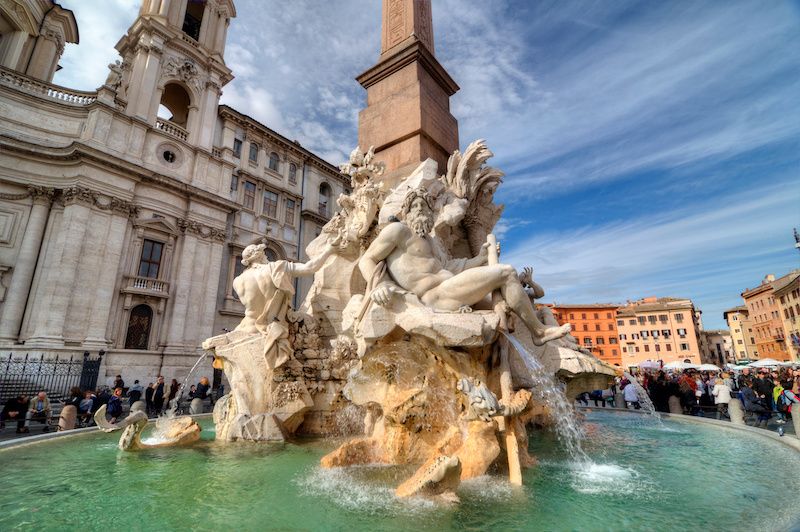The Baroque period in Rome has left clear evidence of a glorious past that restored the grandeur of the Eternal City after decades of decline and neglect. Many monuments were created during this significant historical era, including notable landmarks such as the Church of Sant’Ivo alla Sapienza, Ponte Sant’Angelo, Galleria Borghese, Church of San Luigi dei Francesi, Basilica of Santa Maria del Popolo, and the Capitoline Museums.
One of the most iconic places of this crucial era for Rome is undoubtedly the marvelous Piazza Navona, a symbol of Baroque art. In the splendid setting of this square in the heart of Rome’s historic center, stands the imposing Fountain of the Four Rivers.
Bernini’s Legacy: The Creation of the Fountain of the Four Rivers
From the early 1600s, Pope Innocent X initiated a massive urbanization process throughout Rome, particularly at Piazza Navona, where efforts were made to transform it into an open-air representation of Baroque architecture. In 1651, the pontiff entrusted Gian Lorenzo Bernini with the task of creating a majestic sculpture—the Fountain of the Four Rivers, centered around a towering 16-meter-high obelisk. The new construction aimed to exalt the grandeur of the Catholic Church and the Pamphili family, to which the pope belonged.
A Perfect Fusion of Sculpture and Architecture
For its complex execution, Bernini enlisted the support of a substantial group of artists and craftsmen working under his direct supervision. The result was a true masterpiece—a perfect symbiosis of architecture and sculpture. The fountain was designed and crafted to resemble a massive rock formation supporting the imposing granite obelisk from the Circus of Maxentius on the Appian Way. On the corners of the travertine rock are sculpted marble statues depicting the four rivers representing the continents known at the time, accompanied by associated animals: Danube by Antonio Ercole Raggi for Europe with a horse, Ganges by Claude Poussin for Asia with an oar and dragon, Nile by Giacomo Antonio Fancelli for Africa with a lion and palm tree, and Río de la Plata by Francesco Baratta for America with a raised arm and an armadillo. On the upper part of the rock, two large marble coats of arms of the pope’s family are depicted, with a dove carrying an olive branch in its beak. The same dove is also found at the top of the obelisk.
Symbolism and Allegory: Unveiling the Secrets of the Fountain of the Four Rivers
Every element of the fountain carries a strong symbolic meaning. The statues of the four rivers are surrounded by symbols representing the arts and sciences, emphasizing the role of the Church as a spiritual and cultural guide. For this reason, the work is a perfect blend of art and allegorical message.
The Fountain of the Four Rivers Today
Visiting this extraordinary example of sculpture and architecture means delving deep into the history and the unique socio-cultural context that led Bernini in the 1600s to build this gem in the one-of-a-kind setting of Piazza Navona. Even today, it attracts thousands of visitors from around the world every year.
Conclusion
To fully comprehend Rome’s glorious past in distant eras, we suggest exploring the Fountain of the Four Rivers and its extraordinary surroundings after spending the first part of the day with a Tour of the Colosseum with Arena Entrance, and feeling like a Gladiator of Ancient Rome for a few hours.


